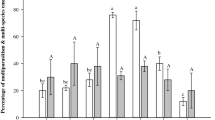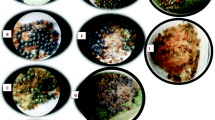Abstract
Trichogramma parasitoids are important biological control agents for insect pest management. However, efficient means for mass production of Trichogramma parasitoids are needed, particularly for T. ostriniae, which often fail to form emergence holes on host eggs of Chinese oak silkworm, Antheraea pernyi, because of the hard chorion. In the present study, we evaluated the possibilities to enhance adult emergence of T. ostriniae by utilizing emergence holes made by T. dendrolimi during multiparasitism on host eggs of A. pernyi and other biological parameters such as pre-emergence time, parasitism rate, and emergence rate of the two parasitoids, which were also evaluated between the two parasitism regimes of multi- and monoparasitism. Our data showed that multiparasitism on host eggs of A. pernyi significantly facilitated the emergence of adult T. ostriniae. Generally, both Trichogramma species favored parasitizing A. pernyi eggs, with multiple parasitoid adults emerged per host egg. The overall performance of T. dendrolimi was similar between the two parasitism regimes, although a significantly higher number of unemerged adults were found in the multiparasitized eggs than in the monoparasitized. For T. ostriniae, significantly more adults emerged, and a higher emergence rate was recorded on host eggs multiparasitized with T. dendrolimi than that on monoparasitized. Furthermore, significantly fewer unemerged adults were found in multi- than monoparasitized host eggs. The results of this study provided useful information on the feasibility of mass production of T. ostriniae via multiparasitism with T. dendrolimi on large eggs of A. pernyi.

Similar content being viewed by others
References
Andrade GS, Pratissoli D, Dalvi LP, Desneux N, Goncalves HJ (2011) Performance of four Trichogramma species (Hymenoptera: Trichogrammatidae) as biocontrol agents of Heliothis virescens (Lepidoptera: Noctuidae) under various temperature regimes. J Pest Sci 84:313–320
Blanche S, Casas J, Bigler F, Janssen-Van Bergeijk KE (1996) An individual-based model of Trichogramma foraging behaviour: parameter estimation for single females. J Appl Ecol 33:425–434
Chailleux A, Desneux N, Seguret J, Maignet P, Khanh HDT, Tabone E (2012) Assessing European egg parasitoids as a mean of controlling the invasive South American tomato pinworm Tuta absoluta. PLoS ONE 7:e48068
Chailleux A, Biondi A, Han P, Tabone E, Desneux N (2013) Suitability of the pest-plant system Tuta absoluta (Lepidoptera: Gelechiidae)—tomato for Trichogramma (Hymenoptera: Trichogrammatidae) parasitoids and insights for biological control. J Econ Entomol 106:2310–2321
Du Z, Qiu X (1988) Discovery of associated parasitism of egg parasite in Dendrolimus punctatus Walker. J Zhejiang For Sci Technol 8:27–31
Du WM, Xu J, Hou YY, Lin Y, Zang LS, Yang X, Zhang JJ, Ruan CC, Desneux N (2017) Trichogramma parasitoids can distinguish between fertilized and unfertilized host eggs. J Pest Sci. https://doi.org/10.1007/s10340-017-0919-2
Guo MF (1985) Discrimination of Trichogramma japonicun and other species of Trichogramma for hosts and competition among them. Nat Enem Insect 7:192–200
Greenberg SM, Gorban VP, Liu TX (2015) Production of factitious hosts for Trichogramma and equipment needs. In: Vinson SB, Greenberg SM, Liu TX, Rao A, Volosciuk LF (eds) Biological control of pests using Trichogramma: current status and perspectives. Northwest A&F University Press, Yangling, pp 86–103
Han SC, Chen QX, Liu WH, Zhang ML (1993) Studies on interspecific competition between Anastatus japonicus and Trichogramma dendrolimi on host eggs. Nat Enem Insect 15:10–13
Hassan SA (1993) The mass rearing and utilization of Trichogramma to control lepidopterous pests: achievements and outlook. Pestic Sci 37:387–391
Hassan SA, Liscsinszky H, Zhang G (2004) The oak-silkworm egg Antheraea pernyi (Lepidoptera: Anthelidae) as a mass rearing host for parasitoids of the genus Trichogramma (Hymenoptera: Trichogrammatidae). Biocontrol Sci Technol 14:269–279
Huang SS, Zang LS, Ruan CC (2013) Parasitization ecology, mass production, and application of Trichogramma. Science Press, Beijing, pp 116–140
Li LY (1994) Worldwide use of Trichogramma for biological control on different crops. A survey. In: Wajnberg E, Hassan SA (eds) Biological control with egg parasitoids. CAB International, Wallingford, pp 37–51
Ni LX, Tong XW, Lao XM (1994) Influence of multiparasitism of egg parasitoids of pine lasiocampids on efficacy of biological control. Acta Entomol Sin 37:145–152
Pinto JD (1992) Novel taxa of Trichogramma from the New World tropics and Australia (Hymenoptera: Trichogrammatidae). J N Y Entomol Soc 100:621–633
Pu ZL, Liu ZC (1962) Sugarcane borer control by Trichogramma evanescens Westw. Acta Entomol Sinica 4:409–414
SAS Institute (2010) SAS/STAT v.9.1. SAS Institute, Cary, NC, USA
Shi ZH, Liu SS (2003) Interspecific interactions between Cotesia plutellae and Oomyzus sokolowskii, two major parasitoids of diamondback moth, Plutella xylostella. Chin J Appl Ecol 14:949–954
Smith SM (1996) Biological control with Trichogramma: advances, success, and potential of their use. Ann Rev Entomol 41:375–406
Song LW, Wen XY, Zang LS, Ruan CC, Shi SS, Shao XW (2015) Parasitism and suitability of different egg ages of the Leguminivora glycinivorella (Lepidoptera: Tortricidae) for three indigenous Trichogramma species. J Econ Entomol 108:933–939
Stouthamer R, Hu J, van Kan FJPM, Platner GR, Pinto JD (1999) The utility of internally transcribed spacer 2 DNA sequences of the nuclear ribosomal gene for distinguishing sibling species of Trichogramma. Biocontrol 43:421–440
Wang ZY, He KL (2014) Mass rearing and release of Trichogramma for biological control of insect pests of corn in China. Biol Control 68:136–144
Wang ZY, Lu X, He KL, Zhou DR (2000) Review of history, present situation and prospect of the Asian maize borer research in China. J Shenyang Agric Univ 31:402–412
Wang YH, Chen LP, Yu RX, Zhao XP, Wu CX, Cang T, Wang Q (2012) Insecticide toxic effects on Trichogramma ostriniae (Hymenoptera: Trichogrammatidae). Pest Manag Sci 68:1564–1571
Wang XY, Jennings DE, Duan JJ (2015) Trade-offs in parasitism efficiency and brood size mediate parasitoid coexistence, with implications for biological control of the invasive emerald ash borer. J Appl Ecol 52:1255–1263
Yuan XH, Song LW, Zhang JJ, Zang LS, Zhu L, Ruan CC, Sun GZ (2012) Performance of four Chinese Trichogramma species as biocontrol agents of the rice striped stem borer, Chilo suppressalis, under various temperature and humidity regimes. J Pest Sci 85:497–504
Zang LS (2015) Mass production of Trichogramma dendrolimi using eggs of Antheraea pernyi, and field application in the suppression of Ostrinia furnacalis in Jilin Province, China. IOBC Newsl 98:9
Zhang J, Wang JL, Cong B, Yang CC (1990) A faunal study of Trichogramma [Hym.:Trichogrammatidae] species on Ostriniae furnacalis [Lep.: Pyralidae] in China. Chin J Biol Control 6:49–53
Zhang JJ, Desneux N, Benelli G, Zang LS, Du WM, Ruan CC (2017a) Geographic variation of diapause induction rates in Trichogramma drendrolimi (Hymenoptera: Trichogrammatidae) in China. J Econ Entomol 110:386–391
Zhang JJ, Zhang X, Zang LS, Du WM, Hou YY, Ruan CC, Desneux N (2017b) Advantages of diapause in Trichogramma dendrolimi mass production via eggs of the Chinese silkworm, Antheraea pernyi. Pest Manag Sci. https://doi.org/10.1002/ps.4795
Acknowledgements
This research was funded by the National Natural Science Foundation of China (31572058) and the National Key R&D Program of China (2017YFD0201000).
Author information
Authors and Affiliations
Corresponding authors
Ethics declarations
Conflict of interest
The authors declare no conflicts of interest.
Additional information
Communicated by M. Traugott.
Rights and permissions
About this article
Cite this article
Li, TH., Tian, CY., Zang, LS. et al. Multiparasitism with Trichogramma dendrolimi on egg of Chinese oak silkworm, Antheraea pernyi, enhances emergence of Trichogramma ostriniae. J Pest Sci 92, 707–713 (2019). https://doi.org/10.1007/s10340-018-1018-5
Received:
Revised:
Accepted:
Published:
Issue Date:
DOI: https://doi.org/10.1007/s10340-018-1018-5




